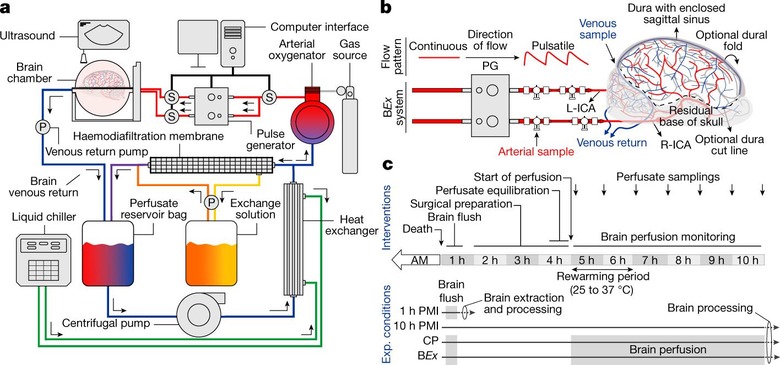Pig Brain Lives Outside Corpse After Beheading
So you want to know more about how researchers brought a dead pig brain back to life outside its corpse. Today we're going to talk about this very subject, a pig-brain experiment the likes of which have brought about some ethical questions. This experiment began with researchers at Yale University in New Haven, Connecticut, along with the severed heads of 32 pigs.
32 fresh pig heads
Yale neuroscientist Nenad Sestan wanted to know if a brain – an entire brain, not just the rudimentary parts – could be revived. Revived, that is, several hours after the death of the owner of said brain. To perform experiments to see about this zombie-making sort of situation, Sestan visited a local slaughterhouse.
Sestan obtained the dismembered heads of 32 pigs that'd been murdered for meat that very day. Approximately four hours after each pig's untimely death, a process was started. Each pig skull was opened, and each pig brain was removed. Each pig brain was placed into a "special chamber" and fitted with a catheter.
Through the catheter, each pig brain was pumped full of a preservative liquid they called BrainEx. Yes, BrainEx, we did not make that name up – that is the name these searchers gave to the nutrient and oxygen-filled liquid. This liquid was pumped through each pig brain's veins and arteries... and researchers watched, and monitored.

To make absolutely certain that no undead sort of funny business went on, researchers kept anesthetics handy. Electrical activity was kept under close watch so that if the organ seemed to be regaining consciousness, they'd be able to numb potential "pain".
The liquid BrainEx also contained "chemicals that stop neurons from firing". This was to prevent electrical brain activity from restarting, and to protect neurons from themselves. DO NOT WORRY about these pig brains feeling pain – they never actually reached a point at which they could be considered conscious, and no "coordinated electrical patterns across the entire brain" were witnessed whatsoever.
What is "alive", anyway?
Each pig brain was monitored on BrainEx for a period of six hours. During that time, researchers found that brain cells and neurons had "restarted normal metabolic functions". That includes producing carbon dioxide and consuming sugar. Researchers also found that individual neurons could still carry a signal through electrical current.
The question "what is alive" is tricky – in a big way because the most obvious answer is "that which is not dead". If we're talking about Game of Thrones and the Greyjoy family, we get even trickier.
If we can agree that "life" means having biological processes, either signaling or self-sustaining (or hopefully both), these pig brains might well have been alive, if only for a short time. But they weren't self-sustaining – and they weren't particularly animate.
Why is this happening?
Because humans want to know as much about every single thing in the universe as they can, for the most part. Also bringing organs – not just brains – back to life could have awesome implications. Like testing drugs on reanimated organs – without the danger of harming any connected human subject.
"This paper throws a hand grenade into the middle of what the common beliefs are," said Lance Becker, an emergency-medicine specialist at the Feinstein Institute for Medical Research in Manhasset, New York. "We may have vastly underestimated the ability of the brain to recover."
For more information on this subject, head over to the research paper "Restoration of brain circulation and cellular functions hours post-mortem" in Nature.
This paper was authored by Zvonimir Vrselja, Stefano G. Daniele, John Silbereis, Francesca Talpo, Yury M. Morozov, André M. M. Sousa, Brian S. Tanaka, Mario Skarica, Mihovil Pletikos, Navjot Kaur, Zhen W. Zhuang, Zhao Liu, Rafeed Alkawadri, Albert J. Sinusas, Stephen R. Latham, Stephen G. Waxman, & Nenad Sestan. This paper can be found with the code DOI:10.1038/s41586-019-1099-1 in Nature 568, pages 336–343 (2019).
